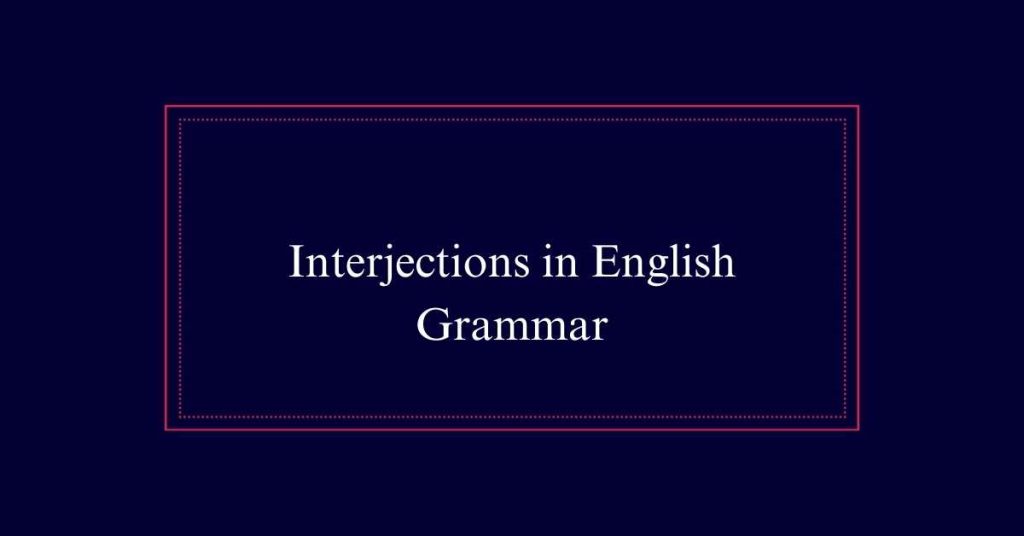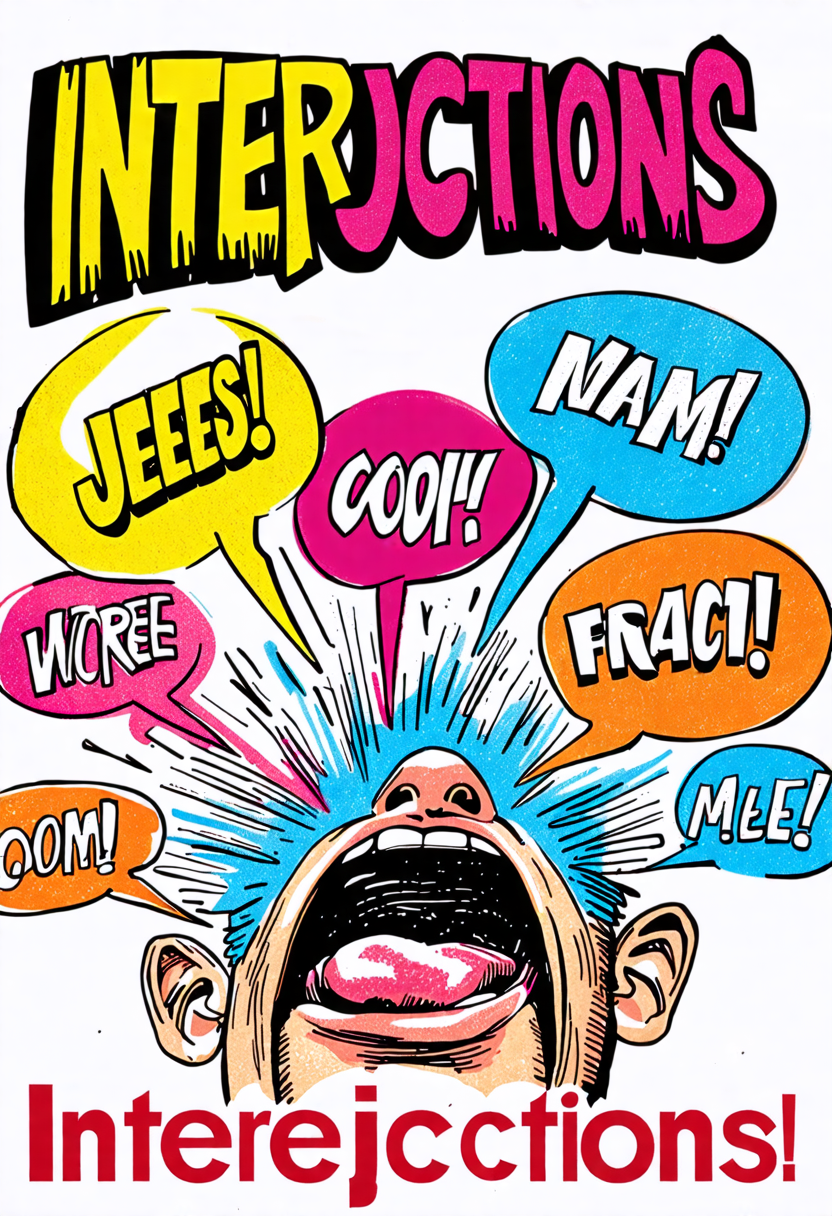Interjections in English Grammar
Interjections are words or phrases used to express sudden emotions or reactions. Examples include “Wow!”, “Ouch!”, and “Hooray!”. They can convey surprise, joy, pain, or excitement. Interjections can stand alone or be integrated into sentences to add emotional emphasis.
What Are Interjections?
Interjections are words or phrases that express sudden emotions or reactions within a sentence. They convey surprise, excitement, or other strong feelings. Interjections can stand alone or be part of a sentence. They often appear with exclamation points to emphasize the emotion.
For example, ‘Wow!’ or ‘Oh no!’ Placement within a sentence is flexible; they can be at the beginning, middle, or end. Interjections like ‘oh,’ ‘ouch,’ and ‘hey’ add emotional depth. They are commonly used in casual and informal writing. In formal contexts, their use is limited as they might reduce the seriousness of the text.
Types of Interjections
Various types of interjections serve to express different emotions and reactions in language. Primary interjections consist of simple sounds or words like ‘oh,’ ‘ah,’ and ‘wow.’ These convey basic emotions such as surprise, pain, or joy.
Secondary interjections are longer phrases, such as ‘oh my’ and ‘good grief,’ which tend to express more complex emotions or reactions.
Emotive interjections like ‘ouch’ or ‘eek’ express immediate physical or emotional responses.
Cognitive interjections, such as ‘hmm’ or ‘aha,’ indicate thought or realization.

Standalone Interjections
Standalone interjections are powerful tools for conveying surprise or excitement in writing. These interjections can stand alone, often using an exclamation point to add emphasis. Examples include words like ‘Wow!’, ‘Ouch!’, and ‘Hooray!’. They capture the reader’s attention and express strong emotions instantly.
Although they can be used without additional context, the surrounding sentences often provide the necessary background.
Standalone interjections are versatile and can be used in casual or informal writing. They bring a dynamic quality to text, making it more engaging.
Flexible Placement
The placement of interjections within a sentence is remarkably flexible, allowing writers to insert them almost anywhere to enhance expression.
This flexibility means that interjections can appear at the beginning, middle, or end of sentences. Each position can serve a different purpose and impact the overall tone of the writing.
Beginning of a Sentence: To immediately capture attention. Example: ‘Wow, that’s amazing!’
Middle of a Sentence: To add emphasis or interject a thought. Example: ‘The show, oh my, was spectacular.’
End of a Sentence: To conclude with emotion. Example: ‘She finally arrived, hooray!’
Standalone: To express a reaction independently. Example: ‘Oops!
Interjections in Sentences
Interjections in sentences often act as parenthetical elements, adding emotion and emphasis. They are typically set off with commas or parentheses to distinguish them from the main sentence.
For example, ‘I may not succeed, but, hey, at least I tried,’ uses ‘hey’ to convey a casual tone. Similarly, ‘The project was delayed because the logistics team made a few (ahem) miscalculations,’ uses ‘ahem’ to hint at a mistake humorously.
Properly placed interjections can enhance the tone and make sentences more engaging. They allow writers to express emotions like surprise, relief, or sarcasm. However, interjections should be used sparingly to maintain clarity and avoid cluttering the text.
Casual and Informal Use
In casual and informal writing, interjections serve to inject personality and emotion into the text. They help convey feelings and reactions more vividly. Here are four reasons why interjections are effective in such contexts:
- Express Emotion: Interjections like ‘wow’ or ‘ouch’ quickly convey feelings.
- Enhance Dialogue: They make conversations more realistic and lively.
- Add Humor: Words like ‘oops’ or ‘aha’ can introduce a light-hearted tone.
- Engage Readers: Interjections grab attention and make content more relatable.
Avoiding Formal Writing
Avoid using interjections in formal writing to maintain professionalism and seriousness. Interjections often convey emotion and spontaneity, which can undermine the formal tone required in professional documents. In academic papers, business reports, and official correspondence, clarity and precision are paramount.
Interjections like ‘wow,’ ‘oops,’ or ‘hurrah’ can make the writing appear casual and unstructured. Instead, opt for clear and direct language to convey your message. Formal writing should be free from elements that might distract or confuse the reader.
Adding Emotion and Expression
While formal writing demands restraint, casual writing benefits from interjections that add emotion and expression. Interjections help convey feelings and reactions instantly, making the text more relatable and lively. They can transform a mundane sentence into an engaging one, reflecting the writer’s genuine sentiments.
Consider the following:
- Surprise: ‘Wow, that was unexpected!’
- Joy: ‘Yay, we did it!
- Disappointment: ‘Oh no, we missed the deadline.’
- Relief: ‘Phew, that was close.’
Enhancing Tone and Engagement
Interjections can greatly enhance the tone and engagement of casual writing. They add a burst of emotion and immediacy, making the text more lively and relatable.
By using interjections, writers can convey their feelings directly to the reader. This can make the writing feel more personal and dynamic. For example, words like ‘wow,’ ‘oops,’ and ‘yay’ can instantly communicate excitement, surprise, or joy.
These elements can break the monotony of regular prose, making the content more engaging. Interjections also help readers feel more connected to the writer’s emotions. This connection can make the text more memorable and impactful.
Guidelines for Usage
Understanding the context is crucial when incorporating interjections into your writing. Interjections can add emotion and authenticity to your text, but their usage must be appropriate to the situation.
Here are four guidelines to follow:
- Consider the Tone: Use interjections in informal and casual settings; avoid them in formal writing.
- Placement Matters: Place interjections at the beginning or within sentences, ensuring they are set off by commas or parentheses.
- Reflect Emotions: Choose interjections that accurately express the intended emotion, whether surprise, joy, or frustration.
- Limit Usage: Overusing interjections can make your writing seem cluttered and less serious.







